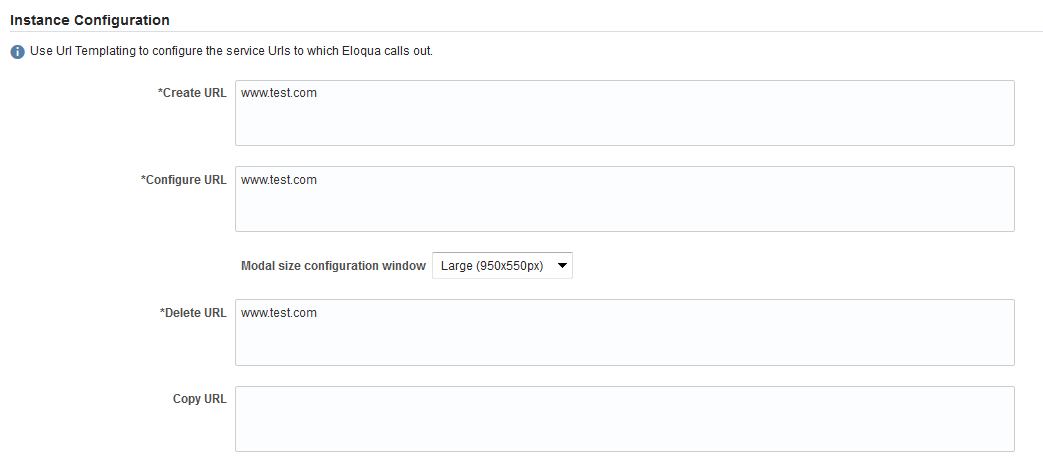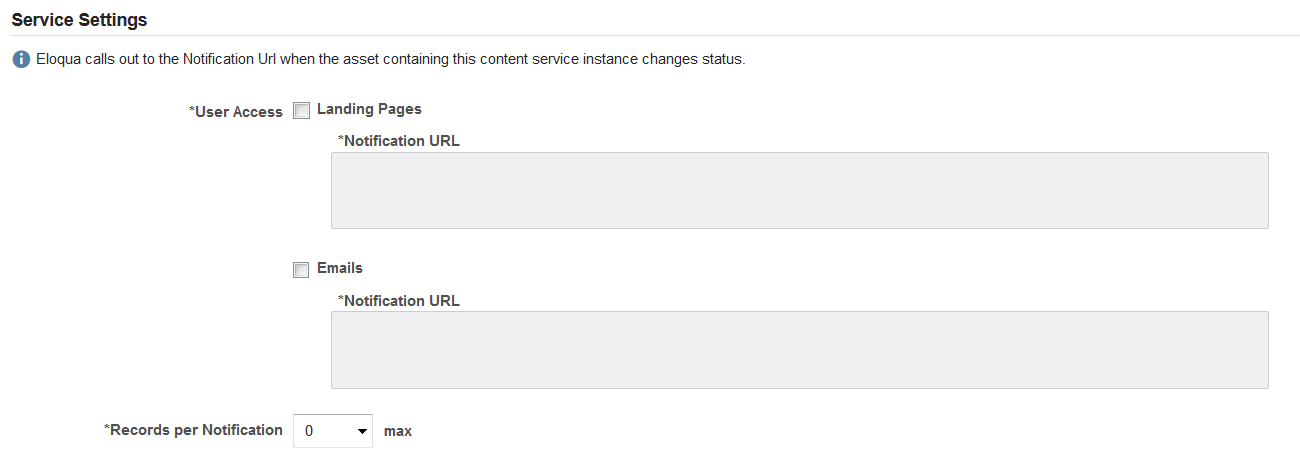Register a content service
Content allows marketers to source pieces of content in Eloqua emails and landing pages, from an external source. This is the new and improved version of Eloqua's cloud components framework, and it includes many improvements such as asynchronous bulk processing (for emails), the ability to fully test the content service within Eloqua, and design-time interaction with the email and landing page editors. For example, you can now resize content in real time.
When you set up a content service, you will need to provide the usual AppCloud developer framework service details, as well as the Instance Configuration and Content Settings.
Service Details
These fields are present for all services:
- Name: the name of the service
- Description: describes what the service does
- 32x32px Icon: the URL of the icon that Eloqua should display for your service. The URL must be
https://
Instance configuration
This section defines the URLs for creating, configuring, copying and deleting an instance of your service. The installation tutorial details the instance creation flow when a creates a landing page or email populated with content.
Each URL is a templated URL that uses common URL template parameters and some Eloqua markup language parameters. Eloqua replaces these paramters with their appropriate values when it makes a call. For more about URL templating, see our Introduction to URL templating.
-
Create URL: A templated URL pointing to a web portal for creating an instance of this service as an HTTP
POSTrequest. All common URL template parameters are available.You should be sure to include, at a minimum, the
{InstanceId}parameter so that you will be able to identify the service in the future. On success, this endpoint should return a 200-level response with the created instance. -
Configure URL: A templated URL pointing to an endpoint for configuring an instance of this service as an HTTP
GETrequest. All common URL template parameters are available.You should be sure to include, at a minimum, the
{InstanceId}parameter so that you will be able to identify the service in the future. -
Modal size configuration window: Select a modal size for your configuration window. The configuration page displays when marketers configure your service.
- Large: 950px x 550px
- Small: 650px x 550px
-
Delete URL: A templated URL pointing to an endpoint for deleting an instance of this service using an HTTP
DELETErequest. All common URL template parameters are available. On success, this endpoint should return a 200-level response. -
Copy URL: A templated URL pointing to an endpoint for creating an instance of this service as an HTTP
POSTrequest. All common URL template parameters are available in addition to{OriginalInstanceId},{OriginalInstallId},{OriginalAssetId}, and{OriginalAssetName}.You should be sure to include, at a minimum, the
{InstanceId}and{OriginalInstanceId}parameters so that you can identify the original and newly created instances. On success, this endpoint should return a 200-level response with the created instance. Learn how to Respond when a marketer copies a service instance.
Service settings
- User Access: Select the Eloqua asset types for which your app should be available.
- Landing Page Notification (HTML) URL: templated URL that Landing Page engines should call out to during render to retrieve the HTML content for the configured instance. In addition to the common HTML template parameters, the notification (HTML) URL supports the
{VisitorId},{Fragment},{Host},{Query}and{Url}parameters. Be sure to include, at a minimum, the the{InstanceId}and{ExecutionId}parameters so that you will be able to call back in to Eloqua. - Email Notification (HTML) URL: templated URL that the email engine should call out to during render to retrieve the HTML content for the configured instance. Be sure to include, at a minimum, the the
{InstanceId}and{ExecutionId}parameters so that you will be able to call back in to Eloqua.
- Landing Page Notification (HTML) URL: templated URL that Landing Page engines should call out to during render to retrieve the HTML content for the configured instance. In addition to the common HTML template parameters, the notification (HTML) URL supports the
- Max Records per Notification: max number of records to push per HTTP request (between 0 and 5,000)
Content settings
- Default Content: the HTML content the system should use if the external service is not accessible. This is a required field and cannot be empty.
- Content Layout: choose from flow or fixed. If you choose flow, the external content is input into your landing page or email with no constraints (except width). If you choose fixed, the external content will be constrained in height and width, as specified by the content instance, and will not be configurable from within Eloqua.
If the landing page or email notification URL is not specified and a landing page or email rendering is required, the default content is used instead.
When you’re done configuring your service, click Save. A green alert message will appear at the top of the page indicating the service has been successfully saved.


